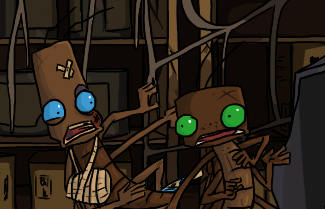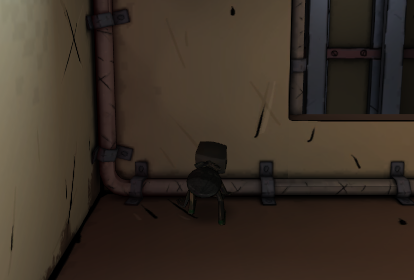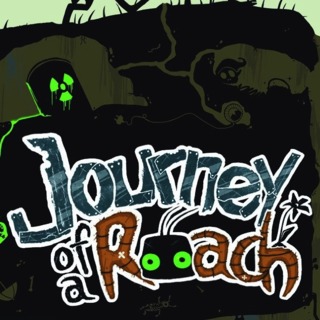INTRO:
Recently, there have been attempts to revitalize the once-dead adventure game genre. Most of these depend on delivering stellar story-writing and presentation over any advancements in gameplay – something that the adventure genre has long lacked. There have been titles that attempt to do the latter, but not every one of them was successful.
Journey of a Roach, developed by Koboldgames, may seem to be one of those unfortunate titles. It promises a lot of fun with the navigation system with which the player controls the player character, but this potential is buried under whimsical presentation and storytelling, as well as an experience with a duration that falls far short of those of better-known adventure titles.
Perhaps Daedalic Entertainment has decided that Koboldgames is the next small game-maker that deserves some spot-lighting. Yet, if this is the case, then the publisher’s decision would arise from a slant towards game-makers that contribute to the slow revitalization of the adventure game genre (of which Daedalic Entertainment specializes in), but does not necessarily have value for the customer in mind.
PREMISE:
Journey of a Roach’s intro starts with a setting that may have been seen many times before. The world that the game is set in is a post-apocalyptic version of ours, albeit ravaged by wars both unconventional (e.g. nukes) and conventional.
Humanity appears to be extinct. Earth is inherited by bugs that have grown to be half as large as humans, but, amusingly, half as smart and twice as reckless. This would be exhibited by two examples of the titular bug.
Bud and Jim are the developer-given names for the two protagonists. Jim is the player character, and he happens to be a bit dim-witted and slightly effeminate; if not for the guidance of a disembodied entity (i.e. the player), Jim would be quite stumped in his day-to-day life – or dead already.
Bud does not have the benefit of a beneficent guardian angel (of sorts), but he is smarter than Jim. Unfortunately, Bud is afflicted with terribly bad luck, and the incompetence of Jim. The consequences can be seen in how Bud seems to be perpetually injured.

It's hard not to snicker a bit in this scene.
It so happens that Bud’s misfortune, and Jim’s lack of wits, would one day have them stumbling into the societies of other bugs – some of them quite unfriendly. In comes the player, having to clean up after their mess and save the day.
NAVIGATION, CAMERA & DIMENSIONS:
After the whimsical intro, the player is introduced to the system that he/she would use to control the main player character, Jim. Jim walks on all six limbs in a primitive manner that hardly resembles a roach, but his insect ancestry would reveal itself when the player discovers that he can walk onto walls and ceilings.
At first, this may take a bit getting used to. This is because the game has a 3D world, but not fully so as it is bounded by the plane in the foreground. Yet, Jim can move into the background as space permits, as well as move in diagonal directions.
Fortunately, the developers have wisely decided that the camera should reorient itself so that Jim’s model becomes the main point of reference of the player’s view.
In other games with such a camera design, the player may still be disoriented when he/she tries to gauge the distance between two objects, neither of which is the player character. In Journey of a Roach, the limitation brought about by the foreground plane helps limit the disorientation significantly.
This navigation system is utilized for many puzzles. However, the sophistication of this utilization can leave much to be desired. Most of them simply have the player character fetching or interacting with something that he otherwise could not if he happens to be standing on merely two limbs.
Moreover, there are limitations to Jim’s climbing of walls and ceilings that may seem dissatisfactory. He can only climb onto walls and ceilings that meet each other without any obstacles obscuring their lines of intersection. Pipes tend to be the most common of these obstacles.
Furthermore, Jim cannot drop or hop onto walls or ceilings that are nearby, even if they are well within reach of his limbs. To get onto these other surfaces, the player must backtrack to the surface that is commonly intersected by both these surfaces and the surface that Jim currently is sticking to, and then move onto these other surfaces from there. This can be tedious. (Fortunately, there are not too many puzzles that require such backtracking.)

Pipes are there to tell the player that Jim cannot move onto other adjacent surfaces.
The oddest absence in the designs of the navigation system is Jim’s lack of flight. Despite clearly having wings, he is not able to use them in meaningful ways at all.
PUZZLES:
The puzzles in the game are the usual point-&-click fare, with some of them requiring some light memorization and logic. There are also puzzles that require the combination of items in the simple inventory system.
Most though, require the player to make a lot of observations, such as examining the whimsical thought bubbles that pop over Jim’s head. Recognition of shapes also happens to be a large part in many puzzles. However, the resolution of some of these puzzles can be bizarre at times.
For example, there is one puzzle that the player would realize has to be solved by stuffing someone into something through observing one of Jim’s thought bubbles and linking the desires of certain characters together. However, said something is apparently too small for said someone.
Yet, the solution would have Jim stuffing said someone into that something anyway, thus betraying the lack of planning in the visual designs for this particular puzzle.
There are puzzles that try to deviate from the genre’s usual norms, or at least do what has been done before using the game’s navigation system. These puzzles are not always satisfying.
An example is one puzzle where the player must navigate a series of obstacles while observing the visual cue that he/she is following the right path. The visual cue would inform the player that he/she is about to veer off from the ideal path, or that he/she has floundered. However, the player is not informed that for the solution of the associated puzzle, he/she has to take a path that almost causes him/her to flounder. In other words, there is not any path where the visual cue remains in a form that indicates a satisfactory route.
Another example is a timing-cum-navigation puzzle where Jim has to dodge hazards or start over. Although this puzzle has some conveniences such as switches that allow the player to disable hazards that have been circumvented, he/she would encounter the problem about climbing walls and ceilings that have been mentioned earlier, and in a way that is more irksome than at other moments in the game.
Although it would be terribly unkind to say that the game has obtuse puzzles, it would be difficult to say that the puzzles in Journey of a Roach are cleverly designed and playtested thoroughly either.
HOTSPOTS:
The game highlights interactive objects with white arrowheads when the player character comes near enough, which is handy, though perhaps not ideal. The player can press a button to have the camera zoom out and have every interactive object on-screen highlighted, but the game does not compensate for the zooming out with bigger arrowheads.
CHARACTER DESIGNS:
Almost all of the characters in the game are human-like facsimiles of bugs, with some bugs resembling commonplace pets like cats and dogs. With such character designs, the player can expect a lot of whimsical humour, such as jokes that are oriented around the characters’ bug ancestors.
For example, there is one scenario in the game where the player has to distract a certain character with a bright lamp. This is a play on the tendencies of certain bugs to fly towards bright lights, for better or worse.
There are also personality designs that seemingly go against the supposed ancestry of these characters. For example, Jim, despite being a roach, expresses disgust at foodstuffs that have gone stale.
Speaking of Jim, he is the character that the player would encounter the most. Yet, he is not exactly a deep character. In fact, he is quite daft.
Jim’s thought bubbles may suggest that he has an inkling of what to do with something, but the player would be reminded that he is quite the idiot when he performs the solution in ways that the player would not expect.
For example, there is one puzzle that requires Jim to use a tool to access a certain object. Instead of using the tool to remove the fasteners on the object, as the player would be led to think via his thought bubble, he would use the tool in the manner of a crowbar instead. The same results are achieved of course.
That is not to say that Jim is difficult to like. Indeed, he is of the adorably bumbling character archetype. Of course, this also means that the player should not expect anything refreshingly amusing about him.
COLLECTIBLES:
Perhaps in an attempt to craft some achievements for the game’s debut on Steam, there are ‘collectibles’ to be retrieved from the game’s environments. These come in the form of grubs, which the game would strongly suggest are the food that Jim (and perhaps Bud) eats.
Getting to these grubs mostly require the player to have a sense of curiosity in exploring his/her surroundings, but there are a few that are almost in plain sight that require the player to do some thinking to get to them.
The inclusion of these grubs is ultimately inconsequential, because the game does not appear to acknowledge their significance to the story beyond said thought bubbles.
VISUAL DESIGNS:
Most of the experience offered by the game plays out in 3D environments that are limited by the foreground plane. In other words, the player would be looking at sectional views of rooms, tunnels and vents, all of them missing the fourth wall.
The 3D graphics would be quite familiar to players that have played Tell-tale’s adventure titles. There is some muted cel-shading for the textures, with soft shadowing and lighting to give the models a convincing semblance of depth.
The models and their animations in the game fit the whimsical nature of the game’s presentation almost well. However, the 3D models obviously lack facial animations. For one, their mouths are little more than textures and bumps on their head polygon. If they have anything to express, they do this through hand gestures and body language instead.
Yet, the most amusing visual occurrences in the game would be presented via sparsely animated 2D artwork. The aforementioned thought bubbles are some of these. They may be black-and-white only, but the silhouettes that they show are more than enough to convey a message and amuse at the same time.
Then, there are comics that take up most of the screen to signal pivotal points in the story. These can be very amusing to watch, if one is into cartoonish and whimsical scenes. On the other hand, these comics also hide the fact that the developers did not design the 3D animations and other assets for these scenes.
AUDIO DESIGNS:
The game has no legible voice-overs whatsoever, despite most of the anthropomorphic bugs clearly having human-like mouths; most of them talk in gibberish. Any understandable ideas of their messages are conveyed mainly through speech or thought bubbles with animated imageries.
Jim has a high-pitched, cutesy voice that is typically used for lovably daft characters, of which he is one. Yet, some other characters, which are not of the same archetype, also have similar voices. This can irk players that find such voices grating. Other than these, there are characters with gruff or harsh voices, which usually appropriately reflect their personalities.
An observant player may suspect that it is just a few persons that are providing the voices, despite their otherwise good attempts to vary their pitches and tones. On the other hand, it can be argued that being a small-time game-maker, Koboldgames does not have a large pool of talent to draw from.
Like the voice-overs, the music in Journey of a Roach contributes to its whimsical presentation. The playful theme in the main menu is a particular example. There are some ominous tunes that can be heard in some places of the game though, suggesting that there might have been plans for a darker tone to the story.
CONCLUSION:
Its whimsical presentation may amuse players, but Journey of a Roach’s indecisiveness on concentrating on either 3D graphics or 2D artwork can give a strong impression that it is a small project that had been converted into a commercial title. Its sometimes troubled navigation system for the player character and underutilized backstory also bolster this suspicion. Furthermore, the rather short duration of the experience of the game, especially when compared to Daedelic Entertainment’s other publications. also suggests low value.
Overall, Journey of a Roach may seem like a substantial effort by fledgling indie developer Koboldgames, but considering its limitations and its rather hefty price tag (US$15) at this time of writing, this title would be very difficult to recommend as a stand-alone purchase.

